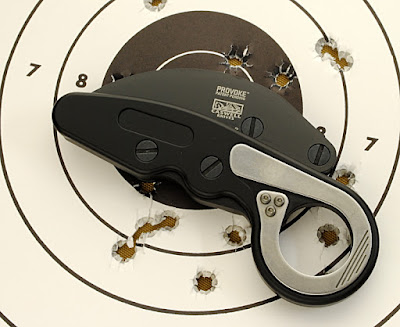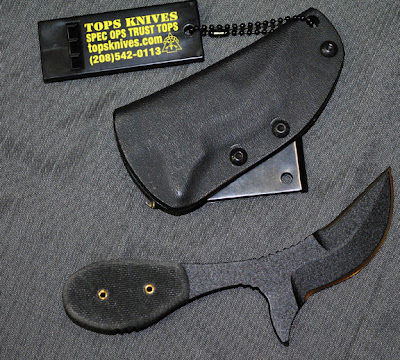“Captain, she’s phasing. I can’t stop the dilithium drive occultations. We’re entering intercostal space!”
Don’t worry, the brilliant chief engineer and intrepid captain, with the help of a beautiful alien female scientist, will solve the problem.
Let’s
be real. Intercostal space is the
distance between ribs. Around 2001
Massad Ayoob designed a folding knife to fit between the ribs and lacerate the
heart. The design locked the blade open
at an angle of less than 180 degrees.
This allows you to utilize the knife with the wrist very close to the
strong, neutral position. More on that
later. Spyderco has re-issued it as a
sprint run.
 |
| Stolen from University of Nottingham - Note the heart and intercostal space. |
The original was produced as both a fully serrated and plain edge with a black Almite handle and a blade made from VG-10. Almite is a surface coating used on aluminum for decorative and protective reasons. It is available from “super hard” to “soft” with differing Vickers hardness.
 |
| The Ayoob sprint run. The handle is a lighter gray. |
VG-10 was initially produced for Japanese chefs. Its properties soon caught the attention of other knife companies. Spyderco was not the only one to utilize this steel. Kizer, SOG and Fällkniven are among VG-10 users.
By
the way - - if you aren’t reading this at “The Knife Edge: One Man, So Many
Knives,” it has been stolen and used without my permission. Please let me know at Frank1karl@yahoo.com.
Years ago, Joyce Laituri told me Spyderco didn’t like making knives whose sole purpose was to harm people. But they would if agencies requested those designs. The Ayoob was in the 2001 and 2002 catalogs but disappeared in 2003.
 |
| Note the angle between the blade and handle. |
The
current Ayoob C60GPGY has a G-10 handle over steel liners. The scales are set up so you can move the
pocket clip to facilitate your favorite carry method. The clip holds the knife slightly visible in
your pocket, an important consideration for anyone concerned about concealed weapons. The visible portion of the knife eliminates
the concealed aspect. A David Boye
release lever is incorporated to reduce the possibility of your grip accidentally
unlocking the knife. I don’t believe
there are any actual documented cases other than those few that were engineered
to demonstrate the potential.
The steel used on the sub-four-inch blade is CPM CRU-WEAR. It is an interesting steel, but you should know its limitations. The elemental composition gives it better wear properties than D2 tool steel, better toughness than M2 steel, and more compression strength than either. The properties of any metal are essentially a teeter-totter. Raise one property and another property sinks.
CRU-WEAR has only 7.24% chromium. The steel’s carbides are primarily produced by 2.4% vanadium and 1.6% molybdenum. These tiny carbides are more of a ceramic particle, very hard, and they pin grain boundaries preventing movement.
With less chromium bound up as carbides, more chromium is available for corrosion resistance. Unfortunately, CRU-WEAR is not a stainless steel. The chromium levels are too low, and Spyderco warns you about that. I’d avoid cutting acid fruit and vegetables, as the acid content will attack and stain the blade. This could be good news to the ketchup patina fans out there.
The choice of steel utilized by any manufacturer can be a rabbit hole exercise in futility. Sometimes it’s market pressure to keep up with the other guys. Sometimes the steel you prefer is no longer available for various reasons. Sometimes it is just a way to keep your staff engaged. Joyce once commented that Spyderco sometimes acts like a small independent maker and tries new steels to stay fresh. It makes it hard on Spyderco collectors, but I like it.
So what makes this fighting knife special?
There
are several things. The first was
already mentioned. The blade is designed
to fit between the ribs and penetrate deep into the chest cavity, lacerating
lungs, heart and other vital structures.
 |
| Deep penetrating injury. |
Perhaps the most notable feature and innovation is the angle between the blade and handle. I’ll let Massad Ayoob explain it. "With a typical knife, thrusting lifts the blade's point above the line of the forearm, like a boat prow going through water. The faster, harder or more resistance encountered, the higher the prow rises deviating the blade off course from its original target which can mitigate the depth of the cut.”
What
Ayoob doesn’t explain, Jim Davis does:
“Regarding wounds, stab wounds are far more prone to kill a person than
slash wounds. Stabs tend to penetrate
and hit arteries and organs, causing internal bleeding.” http://tactical-talk.blogspot.com/2021/01/jim-davis-on-knives.html
When you are fighting for your life, severe measures are called for.
The blade/handle angle allows your wrist to lock into its strongest position, which we call the neutral position. The medical terms for the positions associated with a bent wrist are adduction, extension, and flexion. The joint loses strength when your wrist is in these positions, even if not at the extremes. The Ayoob Clipit lets you cut and stab with your wrist in the neutral position.
 |
| Spyderco's Endura with the wrist in neutral position. The blade tip points upward. |
 |
| Spyderco's Endura with tip canted to engage target. Note bent wrist, compromising grip. |
Spyderco amplifies these ideas, stating: “The C60's radical angle brings the blade
into line with the long bones of the forearm, channeling the body's force
directly behind the line of the cut resulting in minimized blade deviation and
maximized accuracy.”
 |
| Spyderco's Ayoob on target neutral and strong grip position. |
Any knife will open your mail and packages, cut cordage, and slice pizza. Many of these knives will end up as Safe Queens, only seeing the outside on special occasions, holidays and barbeques when you want to show off the knife.
That’s okay. This is a special-purpose knife. I remember listening to a British WWII commando explain how to properly use an F-S fighting knife. You couldn’t use the Ayoob C60GPGY for that. You wouldn’t want to use it to split kindling to build a fire or to saw through a can top when you lost your opener in the back forty acres of nowhere.
Lastly, who is Massad Ayoob, and why should his ideas be put into production? Google his name, will you? Anything I write would sound like hero worship. I admit, he’s a pretty cool guy and someone you want on your side when you’re getting into trouble or trying to survive the aftermath.
The Spyderco Ayoob is a limited sprint run. I find the Ayoob C60GPGY an
attractive knife. You’ve been warned. They’ll run out fast.
 |
| Might be the right backup weapon. |

























